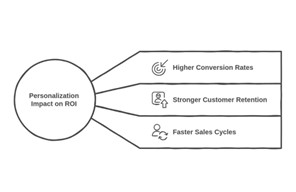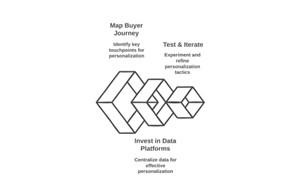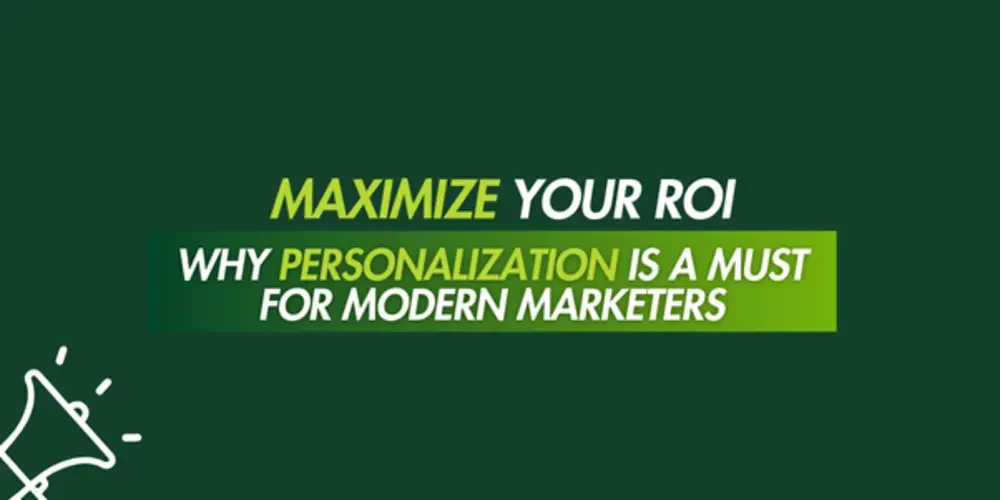Marketing strategies that were once effective in the current world are not sufficient anymore. Mass-produced communication and broad appeals fail to grab attention and customer demands are constantly increasing. Consumers today expect relevance and that is why personalization, once perceived as an additive feature, is now an imperative for revenue. Rather than using generic emails that are sent to large lists, relevant communication, products, and services will be effective at increasing the level of response. For instance, 71% of B2B consumers expect companies to provide them with solutions that meet their business needs in a personalized manner. For today’s marketers personalization is not an activity that is to be pursued but it is a must for improving ROI.
1. The Evolving Role of Personalization: Beyond Basic Segmentation
Marketers who still employ only broad segmentation are losing a great chance. Personalization has moved beyond the level of simple use of the name and the division of the audiences into industries. Today, intent and behavioral data help brands to give consumers exactly what they want at the right time. That is why it can be no shock that 99% of the large companies leverage the intent data and monitoring tools to direct their marketing activities.
While traditional market segmentation is about targeting consumers based on their characteristics, modern personalization is about behavior. One such example could be SaaS companies that allow feature usage to track which prospects have the most involvement and tailor outreach accordingly. If a visitor continually clicks through a specific product feature, that’s a great sign of interest, and they can get a very personalized follow-up with relevant case studies or a demo offer .
Drift is a perfect example of this in action. They utilize AI-enabled chatbots to create personalized experiences on websites based on the role and level of engagement of the visitor. For one with the designation of CMO, he would see messaging regarding high-level strategy, while a Sales Lead would be informed about pipeline development. The result was a 30% increase in qualified leads, proving that done right, personalization can impact business results.
2. Why Personalization Directly Impacts ROI
When it comes to the extent of personalization, the benefits are not just on a theoretical level but it has figures to support. Marketing done right, in other words, messaging that is done in a personalized fashion, increases engagement rate, conversion rate, and customer loyalty. Why? Because people always respond positively when they feel that someone understands them. While a general call to action is not very effective, a personalized call to action will be something people will not overlook. That converts 42% better.

i. Higher Conversion Rates
For example, let us assume you run a Software as a Service (SaaS) company, and your website has a button for demo requests. Then, a simple example of a call-to-action normally used would be to say ‘Book a Demo’. This is not a bad statement; however, there is no hook in it. Imagine, however, that the same CTA changes dynamically based on the visitor’s behavior. For instance, when someone has been on your pricing page, the button might say, “See a Custom Plan for Your Business,” or when someone has read a case study, it might say, “See How X Results Were Achieved by [Customer Name]- Book a demo.” Those little things will absolutely make a world of difference for conversion rates.
ii. Stronger Customer Retention
Personalization doesn’t stop after the first touchpoint; it keeps the customers engaged long after they convert. Personalized onboarding flows lead to higher retention rates because they give users a chance to find value fast. A project management SaaS, for example, could send personalized onboarding emails based on user role. Tips on team collaboration might go out to the product manager, while guides on API integrations might go out to the developer. This targeted approach streamlines onboarding and fosters greater long-term engagement.
iii. Faster Sales Cycles
As personalization is taken into account, sales teams reap the benefits as well. For example, a B2B SaaS company sells a data analytics tool as its product. Rather than sending a follow-up email to all leads for an activity, the company may customize outreach depending on the activity of each prospect. If a CFO downloads a white paper about cost savings, the follow-up email can highlight the financial benefits. If a marketing director registered to a webinar about customer insights, the email may indicate how the tool would increase campaign performance. With all these differences in the prospect’s interest, the company has made sure that every interaction it initiates has relevance and therefore reduces the time it takes to get leads through the funnel and closer significantly faster.
The message is clear: Personalization does not only humanise marketing but is a winning strategy for increasing revenues and customer value, as well as growth.
3. Overcoming Challenges:
However, it’s pretty clear that the significant advantages lie in personalization, yet many marketers are still struggling in its execution. One of the biggest obstacles to personalization is Data Fragmentation. Indeed, 50% of the marketers say that isolated data is their toughest challenge when it comes to effective personalization. When customer data is found on multiple platforms, such as CRMs, email marketing tools, or website analytics, it’s hardly feasible to gain a full picture of one’s audience, even less so to deliver their personalized experiences on a grand scale.
Fortunately, the advancement in technology has made it easier to compile all the requirements as a single package. Web personalization tools centralize behavioral, firmographic, and engagement data into one view for marketers to set up hyper-targeted campaigns without much manual effort. Instead of being scrunched from various customer data platforms, these platforms harness the entire insight to simply trigger personalized messaging based on real-time intent signals.
Scaling Personalization with Dynamic Content
Dynamic content is an excellent way to scale up personalization without burdening with additional complexities. There’s no need to design separate landing pages for every industry or persona; rather, dynamic content modules can adjust themselves on-the-fly. For example, if a hospital executive were to visit your site, they would probably see an ROI calculator specific to healthcare. Meanwhile, other SaaS founders would see case studies that would be specific to their industry. This guarantees a well-tailored experience for all site visitors, but without the need for hundreds of designers and developers to create multiple variations.
Personalization is not inherently complicated. With centralization of data and the use of automated systems, marketers can scale targeted experiences and make personalization practical and sustainable at work.
Actionable Steps for Immediate Impact
Now that we’ve explored how personalization can drive ROI, let’s walk you through some actionable steps that you can implement right away for immediate results.

i. Map the Buyer Journey
Begin mapping out the most significant junctures in your buyer journey on which personalizing will have the most impact, such as what the most critical interactions your prospective customer has with your company are at that point. You can then add personalized messages to these touchpoints. For example, let’s say you work for a SaaS company. After a product demo, rather than sending a generalized “Thanks for joining us” e-mail, personalize the message with reference to what the customer brought up during the demo.
When a prospective client, for example, “Alex,” wonders about particular features during the demonstration, you can directly mention the points while writing your follow-up email. Your email may read thus: “Hi Alex, thanks for your time today! I wanted to dive deeper into how our platform can help with X, as we discussed. Attached is a tailored case study showing how similar businesses benefited from these exact features.” In other words, this type of follow-up shows that you understand what Alex needs, thus making the email more relevant and more valuable.
ii. Invest in Unified Data Platforms
In line with scaling, invest in tools that can centralize your data for personalization. Such as, web personalization tools collect data from disparate sources, such as your site interactions, CRM data, and customer behavior, into one unified platform. For example, you have a lead named Sophia who checked out a few pages on your website but never converted. With a single data platform, you’d be able to track where she went from touchpoint to touchpoint—for example, what pages she visited, what pieces she engaged with, and what emails she opened—as a means of personalizing her experience.
Her time spent on viewing the pricing page and the features section might have led Sophia to some curiosity; hence, the web personalization tool might trigger a pop-up offering her a free trial or personalized demo according to things that interest her. Such tools ensure that your messages aren’t generic but targeted based on real-time behavior, greatly increasing the chance of conversion.
- Test & Iterate
Testing, analyzing, and enhancing – that’s the name of the personalization game. Don’t hesitate to try variations of your content. For instance, if two versions of a landing page exist, one generic and the other personalized with behavior-related information for your users (e.g., a personalized CTA based on the visitor’s industry), test which one converts better.
Suppose a hypothetical example in which an individualized page that attracts healthcare professionals with a specific message outperform the general page by 5%. Though 5% might not sound ‘great’, in time, the conversion effect will compound even at a small percentage turning into a massive improvement on your ROI. The trick is to keep testing and iterating, using data to hone in on an optimal balance between personalization and efficiency.
By following these three steps—mapping the buyer journey, investing in unified data platforms, and continuously testing—you can implement personalization strategies that lead to real, measurable growth.
Conclusion
Gone are the days when run-of-the-mill marketing tactics meant anything to your audience. Customer expectations have evolved to the point that really, personalization is no longer a strategy; it is the very basis for meaningful ROI. It is your means to close the gap and the same means by which it will increase engagement and give today’s buyers what they expect.
Act now, Start an audit of just one campaign, identify where personalization could boost impact, and note those small wins. The resulting incremental improvements will soon aggregate to create a wave of growth across your marketing programs. Remember, companies that prioritize personalization outperform their competitors by 30%.
